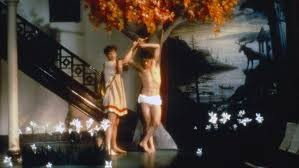performing a confession
by Douglas Messerli
Finally, the theatrical genres Lilies embraces include highly
romantic liturgical renditions of the lives of the saints, cinematic depictions
of young gay boys coming of age, a picaresque-like voyage which ends in
transformation, and, most importantly, and a play-within-a play. Greyson himself
has described his film as a "strange Genet-inflected-via-Fellini fable.”
Accordingly, for those who can’t easily assimilate quick shifts in
narrative language, theatrical genres and tropes, and a radical mix of older
and newer theater conventions, Greyson’s film may at first seem like a mish
mash of traditional and post-modern methods of storytelling. Despite that,
however, Lilies is amazingly fluid in its numerous transformations. And
ultimately I think Greyson has created one of the most remarkable gay films
ever made.
Set
in 1952, the play begins with the rather straight-forward arrival at the Quebec
prison of the local bishop, Jean Bilodeau (Marcel Sabourin) who has agreed to
hear the confession of a now elderly prisoner, Simon Doucet (Aubert Pallascio),
who, sentenced for murder, is now nearing death.
But at the same time, Simon (Jason Cadieux, as his younger version)
playing Sebastian and his friend Vallier (Danny Gilmore) performing as the man
ordered to shoot an arrow into the saint’s
The
performance and attack is observed by Vallier’s slightly dotty mother, the
self-declared Countess de Tilly (Brent Carver)
who—although with her son lives in a derelict shack she describes their house
as a manor and refers to her husband who long abandoned her as a Count doing in
business in Paris—is seemingly delighted by her son’s and Simon’s sexual
kinship. She has come to ask Vallier to accompany her to the event celebrating
the arrival of the French aristocrat Lydie-Anne (Alexander Chapman) about to
enter Roberval in grand style in a hot air balloon.
Clearly, his father’s homophobia has so instilled in the young Simon a
dreadful fear of further abuse or even possible death that he determines to
find a heterosexual mate, abandoning his lover Vallier. Into his life
Lydie-Anne drops like a fairy-tale princess so taken by the boy’s beauty that
they began a relationship that points toward marriage and Simon’s escape from
the rugged rural world of Roberval to Paris.
The sympathetic viewer immediately perceives that the affair between the
two is perverse, not only because of their vast age difference, but because of
the intensity of feelings both boys still share.
The play oddly reveals this perversion in anti-gay and racist
stereotypes that seem counterintuitive
to the homosexual love tale that is at the center of this piece. For, looked at
from outside of the context of the drama, Lydie-Anne is a black drag queen who
we cannot forget has been imprisoned for his crimes who expresses his
character’s supposedly heterosexual love in an obviously swishy lisp that, if
it were not so mimetically cloaked—actor Chapman brilliantly plays his role
completely straight-faced, without even a wink—we might simply dismiss it as
camp.
Hurt,
but nonetheless still supportive of her son’s and Simon’s love (she is,
accordingly, defined by the society as mad) the Countess stands up to
Lydie-Ann’s assertions, to the hoots of horror emanating from Simon’s father,
and to the community leaders gathered at the event. Simon shall remain with Vallier the next morning to
celebrate her son’s birthday in the bathtub which she has reclaimed from a
garbage heap and brought to their shack. The sexual encounter between the two
boys played out in the water of the tub suggests fluids their mouths and cocks
share and emanate, symbolically representing a kind of marriage ceremony that
could never be so beautifully expressed in the heterosexual ceremony Lydie-Ann
had imagined.
For the Countess there is only one more task to be enacted: her own trip
to Paris symbolized by her death. Having chosen a deeply moss-covered tree for
her grave, she demands that her son live up to his familial vows by strangling
her. Strangely, this truly perverse act, a murder of sorts, seems almost
natural and inevitable given her desires and circumstance.
Following the trio into the woods, however, Bilodeau observes her
strangulation and the boy’s sexual embraces after, and threatens to report them
to the police if Simon will not become his lover.
Virulently rejected, Bilodeau sets the bell tower room, in which Simon
and Vallier remain, afire, eventually notifying the school’s staff and the
police. With the door locked by their adversary and without windows for escape
or ventilation, the boys soon lose consciousness in the smoke. With some
regret, Bilodeau returns, pulling Simon to safety but leaving Vallier behind to
die.
In a short epilogue to the play, the now elder prisoner Simon Doucet
confronts the criminal Bishop alone in order to ask a question that has
obviously always haunted him. Was Vallier still alive when Doucet was pulled to
safety? Bilodeau, nodding yes, now asks not only for forgiveness but entreats
Doucet to kill him in revenge. Doucet’s refusal to do so leaves the Bishop to
live out his guilt within the frame of hypocrisy for the rest of his life.*
*One might add, that without the original
playwright or the director of this film version of the work needing to say
anything, the Bishop’s long-ago murder for the rejection of his love resonates
with our recognition of the thousands of young boys who have suffered sexual
abuse from the hands of church elders throughout the years. The film suggests
that it is not the homosexuality that was the crime of so many priests and
church leaders, but their imposition of their love upon the innocent and
unwilling that society cannot forgive. Their crime may not be a physical murder
as in the Bishop’s case, but was a spiritual one that destroyed the trust and
belief their victims had assumed.
Los Angeles, November 5, 2020
Reprinted from My Queer Cinema blog and
World Cinema Review (November 2020).








No comments:
Post a Comment